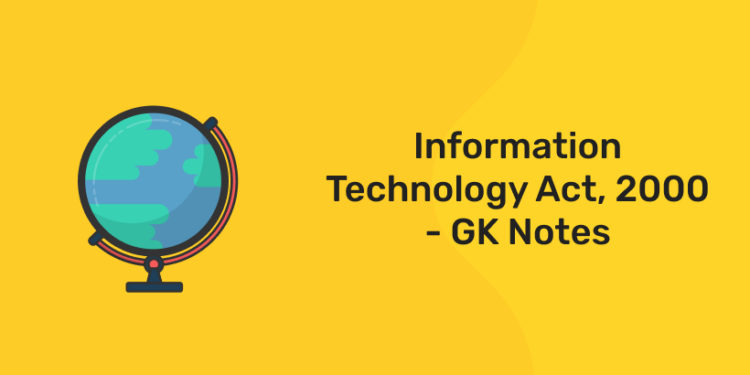Table of Contents
The Information Technology Act, 2000 is a very important topic to be covered for all competitive exams, especially for the Kerala PSC Plus Two Level Mains Exam 2021. The examination for recruitment of posts like Fireman(Trainee)/ Firewoman(Trainee), Civil Police Officer, BEAT Forest Officer, Civil Excise Officer have questions of 2 marks from the topic, Information Technology Act, 2000. This is an Act to provide legal recognition for transactions carried out by means of electronic data interchange and other means of electronic communication, commonly referred to as electronic commerce.
The information technology Act was published on 9 May 2000 and commenced on 17 October 2000. Pramod Mahajan, former minister of Communications and Information Technology introduced this act and it was enacted by the Parliament of India. This Act was later amended in 2008 with some additions. The amendment was mainly aimed at validating electronic signatures and contracts and enforcing cybersecurity.
This amendment has made clear about the responsibility of a particular IP address owner for every activity happening through the same. This also enabled corporations and institutions for effective cybersecurity practices and being responsible for online actions, thereby, people and institutions became more aware of the cybersecurity and malpractices. In this tech- world, knowledge about this act is very relevant and helpful.
Structure of IT Act,2000
The Information Technology Act has 94 sectors, 13 chapters. And four schedules. Each chapter contains separate topics which are of high importance, ranging from preliminary to miscellaneous topics. Basic awareness about all the chapters and its contents will be useful for all the competitive exams.
| No | Chapter |
| 1 | Preliminary |
| 2 | Digital Signature and Electronic Signature |
| 3 | Electronic Governance |
| 4 | Attribution, Acknowledgement and despatch of Electronic Records |
| 5 | Secure Electronic Records and Seure Electronic Signature |
| 6 | Regulation of certifying authorities |
| 7 | Electronic signature certificates |
| 8 | Duties of subscribers |
| 9 | Penalties, Compensation and Adjudication |
| 10 | The Appellate Tribunal |
| 11 | Offences |
| 12 | Intermediaries not to be liable in certain cases |
| 12 A | Examiner of Electronic Evidence |
| 13 | Miscellaneous |
Objectives of Information Technology Act, 2000
- To provide legal framework for electronic governance by giving recognition to electronic records and signature
- To conduct audit of documents,etc maintained in electronic form
- To issue certificates, appointment orders etc in electronic form, thereby having record of every government activities
- To penalise for failure of protection of data or failure to furnish information, return etc.
- To define cybercrimes and penalties for practice of cybersecurity
- To penalise for using technology for false purposes or with the intention of harming an individual/ organisation
- To punish for sending offensive messages through communication service, identity theft, violation of privacy etc
- To prevent hacking of personal information and official information
Important Sections
The chapter 10 of the Information Technology Act 2000, OFFENCES is very important for the Kerala Plus Two level Mains Examination 2021. As per the syllabus released by the Kerala PSC, there will be questions of 2 marks from the IT Act,2000. To crack the exam with high scores, this section is unavoidable. It would be wise to learn all the sections included in the 10th chapter of offenses, which will most probably be asked in the examination.
| Section 43 | Penalty and Compensation for damage to computer, computer system, etc. |
| Section 43A | Compensation for failure to protect data |
| Section 65 | Tampering with computer source documents |
| Section 66 | Computer related offences |
| Section 66B | Punishment for dishonestly receiving stolen computer resource or communication device |
| Section 66C | Punishment for identity theft. |
| Section 66D | Punishment for cheating by personation by using computer resources |
| Section 66E | Punishment for violation of privacy. |
| Section 66F | Punishment for cyber terrorism |
| Section 67 | Punishment for publishing or transmitting obscene material in electronic form. |
| Section 67A | Punishment for publishing or transmitting material containing sexually explicit act, etc in electronic form |
| Section 67B | Punishment for publishing or transmitting material depicting children in sexually explicit act, etc in electronic form |
| Section 72 . | Penalty for breach of confidentiality and privacy |
| Section 77B | Offences with 3 years imprisonment to be bailable |
Overview of Information Technology Act
In short, the Information Technology Act is a law dealing with cyber crimes and electronic commerce, which ensures cybersecurity. The Act ensures that all the government records and documents to be secured, transactions and e-commerce to be safe and eradicates all forms of cyber crimes. The Act has had a tremendous impact on all the cyber areas and people and organisations have become aware of their liability and responsibility for all the activity they are doing in the online electronic medium.
Learning and knowing about such a useful act will be very much useful not just for the competitive exam aspirants, but also for all citizens of the country.
Never stop Learning!












